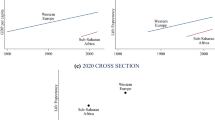Abstract
The recent economic downturn in the USA has coincided with stories of young men and women choosing to remain at home, or to move back in with their parents since they cannot afford to live independently. This paper first describes changes in parental coresidence over the last half-century, and then assesses the causal link between economic conditions and living arrangements among young adults using data on more than 15 million individuals from 1960 to 2011. Comparing changes in economic conditions across US states to changes in living arrangements, I find that fewer jobs, low wages, and high rental costs all lead to increases in the numbers of men and women living with their parents. The magnitudes of the effects are quite large: for men, I estimate that changes in economic factors alone are large enough to have caused the observed changes in parental coresidence between 1970 and 2011.



Similar content being viewed by others
Notes
These figures are taken from Edwards and Hertel-Fernandez (2010), who also document a large decline in labor force participation among young adults during the recent recession.
All figures are based on calculations from the 1960 to 2000 Decennial Censuses, and the 2001 to 2011 American Community Surveys, unless otherwise noted (Ruggles et al. 2008).
See for example Cox (1990).
For example, Kaplan (2012) finds that the ability to move back home allows poorer adults to better smooth consumption during economic downturns by economizing on household expenses.
For other theoretical treatments of the link between economic factors and living arrangements, also see McElroy (1985) and Rosenzweig and Wolpin (1993). While the model presented here is based on parents’ altruism toward their children, others have modeled parental transfers motivated by exchange (Cox 1987) or family constitutions (Cigno et al. 2006). Since these models have the same predictions for changes in coresidence due to changes in economic conditions, no attempt is made to empirically distinguish which model better explains the data.
For example, see Hughes (2003).
See Haurin et al. (1993) for an analysis modeling this simultaneous decision explicitly.
All dollar values are converted to real 2007 dollars using the CPI-U deflator.
While Table 1 does not show the living arrangements for young adults between 17 and 19, 21, and 23, etc., in any given year, the fraction of young adults living with parents is smoothly declining in age, as shown in Figs. 1 and 2. Thus, the patterns in Table 1 would be quite similar if living arrangements were reported within 4-year age groups (i.e., 16–19, 20–23, etc.).
I focus on the 20 to 30 age range only because the changes in parental coresidence are concentrated in this age group in all regions.
Changes in living arrangements for Hispanics (not shown) were similar to those for Whites.
See for example, Roberts (2010).
I have also estimated models that control for the employment-population ratio and wages of women. These controls attenuate the coefficients on the own-gender economic variables somewhat, but they remain significant with similar signs. The reduced coefficients are consistent with an explanation that part of the impact of the economy is working through the marriage/cohabitation market, but it might also be that the female wage and employment variables are correlated with different aspects of the strength of the labor market for men that also affect living arrangements.
For example, Wozniak 2010 shows that migration caused by relative changes in local labor market conditions explains only a small fraction of the migration of 21 to 30 year olds—the age group with the highest migration rates. Due to differences in the migration data available in the Census and American Community Survey (the former records 5-year migration information, whereas the latter records 1-year migration status), I re-estimated the specifications in Tables 2 and 3 adding a control for inter-state migrant status separately for 1970–2000 using Census data and for 2001–2011 using ACS data. The qualitative results were unchanged, with the estimated impact of both employment and wages being slightly more positive.
References
Becker GS (1981) A Treatise on the Family, Cambridge, MA
Bertrand M, Duflo E, Mullainathan S (2004) How much should we trust differences-in-differences estimates. Q J Econ 119(1):249–275
Bitler M, Gelbach JB, Hoynes HW, Zavodny M (2004) The impact of welfare reform on marriage and divorce. Demography 41(2):213–236
Card D, Lemieux T (2000) Adapting to Circumstances: The Evolution of Work, School, and Living Arrangements Among North American Youth. In: Youth Employment and Joblessness in Advanced Countries: nber.org, pp. 171–214
Carlson M, McLanahan S, England P (2004) Union formation in fragile families. Demography 41(2):237–261
Cigno A, Giannelli G, Rosati F (2006) Is there such a thing as a family constitution? A test based on credit rationing. Rev Econ Househ 4:183–204
Cox D (1987) Motives for private income transfers. J Polit Econ 95(3):508–546
Cox D (1990) Intergenerational transfers and liquidity Constraints. Q J Econ 105(1):187–217
Danziger S, Jakubson G, Schwartz S, Smolensky E (1982) Work and welfare as determinants of female poverty and household headship. Q J Econ 97(3):519–534
Edwards KA, Hertel-Fernandez A (2010) The Kids Aren’t Alright A Labor Market Analysis of Young Workers. Technical report, Economic Policy Institute
Ermisch J (1999) Prices, parents, and young people’s household formation. J Urban Econ 45:47–71
Glick PC, Lin S-L (1986) More young adults are living with their parents: who are they?. J Marriage Fam 48(1):107–112
Goldscheider FK, DaVanzo J (1985) Living arrangements and the transition to adulthood. Demography 22(4):545–563
Goldscheider FK, DaVanzo J (1989) Pathways to independent living in early adulthood: marriage, semiautonomy, and premarital residential independence. Demography 26(4):597–614
Haurin DR, Henderschott PH, Kim D (1993) The impact of real rents and wages on household formation. Rev Econ Stat 75:284–293
Hughes ME (2003) Home economics: metropolictan labor and housing markets and domestic arrangements in young adulthood. Soc Forces 81(4):1399–1429
Kaplan G (2012) Moving back home: insurance against labor market risk. J Polit Econ 120(3):446–512
Lichter DT, McLaughlin DK, Ribar DC (2002) Economic restructuring and the retreat from marriage. Soc Sci Res 31:230–256
McElroy MB (1985) The joint determination of household membership and market work: the case of young men. J Labor Econ 3(3):293–316
McLaughlin DK, Lichter DT (1997) Poverty and the marital behavior of young women. J Marriage Fam 59:582–594
Moffitt R (1992) Incentive effects of the U.S. welfare system: a review. J Econ Lit 30(1):1–61
Olsen RJ, Farkas G (1990) The effect of economic opportunity and family background on adolescent cohabitation and childbearing among low-income blacks. J Labor Econ 8(3):341–362
Roberts S (2010) Facing a Financial Pinch, and Moving in with Mom and Dad, New York Times
Rosenzweig MR, Wolpin KI (1993) Intergenerational support and the life-cycle incomes of young men and their parents: human capital investments, coresidence, and intergenerational financial transfers. J Labor Econ 11(1):84–112
Ruggles S, Sobek M, Alexander T, Fitch CA, Goeken R, Hall PK, King M, Ronnander C (2008) Integrated Public Use Microdata Series: Version 4.0 [Machine-readable database], Minneapolis, MN
Ruiz RR (2010) Recession Spurs Interest in Graduate, Law Schools, New York Times
Saks RE, Wozniak A (2011) Labor reallocation over the business cycle: new evidence from internal migration. J Labor Econ 29(4):697–739
Sassler S, Schoen R (1999) The effects of attitudes and economic activity on marriage. J Marriage Fam 61(1):147–159
Shin D, Solon G (2008) Trends in Men’s Earnings Volatility: What Does the Panel Study of Income Dynamics Show? National Bureau of Economics Research Working Paper, No. 14075
Smock PJ, Manning WD (1997) Cohabiting partners’ economic circumstances and marriage. Demography 34(3):331–341
Sweeney MM (2002) Two decades of family change: the shifting economic foundations of marriage. Am Sociol Rev 67(1):132–147
Wang W, Morin R (2009) Home for the Holidays... and Every Other Day, Technical report, Washington, D.C
Whittington LA, Peters HE (1996) Economic incentives for financial and residential dependence. Demography 33(1):82–97
Wozniak A (2010) Are college graduates more responsive to distant labor market opportunities? J Hum Resour 45(4):944–970
Acknowledgments
I thank the editor, two anonymous referees, and Sheldon Danziger, Susan Dynarski, Steven Raphael, Daniel Lichter, Kelly Musick, Sharon Sassler, and participants at a MacArthur network discussion group for helpful comments and suggestions. Comments are welcome at jdm296@cornell.edu.
Author information
Authors and Affiliations
Corresponding author
Additional information
Responsible Editor: Alessandro Cigno
Rights and permissions
About this article
Cite this article
Matsudaira, J.D. Economic conditions and the living arrangements of young adults: 1960 to 2011. J Popul Econ 29, 167–195 (2016). https://doi.org/10.1007/s00148-015-0555-y
Received:
Accepted:
Published:
Issue Date:
DOI: https://doi.org/10.1007/s00148-015-0555-y




